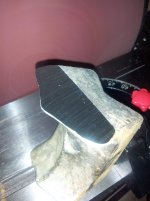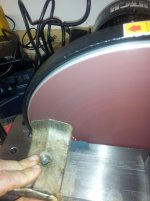fishfactor
Gold Member
If you run a mulcher with knives, you know how important it is to keep the correct angle and a flat surface from the cutting edge back at least 1-1.5 inches. New teeth cut like a razor. Trying to keep the correct angle and a flat surface with a grinder in the field isn't the easiest. It's hard for me not to sharpen the edge too much and develop a curved surface, especially on the fecon samurai teeth.
Found this 12" disc grinder(sander) at northern. It uses 12" sand paper discs. I was very skeptical at first concerning the life of the sand paper, but have been surprised. I took teeth that I had put in the scrap pile and got them back to good as new in 2-3 minutes each side. Actually faster than I could get them back to OK condition with an angle grinder. The table it comes with tilts both negative and positive, so you can get the angle you want.
I realize this will not be ideal for a majority of operators, but I found a solution that works for us. We run carbides most of the time, but put 10 knives in the middle of the drum when we are in large material. We have a large gas powered air compressor, so changing them only takes a few minutes with a 3/4 impact. If the teeth aren't bad, we touch them up with a grinder on the machine, but have found that we can actually save time when they get beat up to pull them off and get the angle and edge back to like new. We typically carry 30 knives with 2 sides. So if they are all sharp when we start, we can get 6 changes before we need to sharpen them all.


Found this 12" disc grinder(sander) at northern. It uses 12" sand paper discs. I was very skeptical at first concerning the life of the sand paper, but have been surprised. I took teeth that I had put in the scrap pile and got them back to good as new in 2-3 minutes each side. Actually faster than I could get them back to OK condition with an angle grinder. The table it comes with tilts both negative and positive, so you can get the angle you want.
I realize this will not be ideal for a majority of operators, but I found a solution that works for us. We run carbides most of the time, but put 10 knives in the middle of the drum when we are in large material. We have a large gas powered air compressor, so changing them only takes a few minutes with a 3/4 impact. If the teeth aren't bad, we touch them up with a grinder on the machine, but have found that we can actually save time when they get beat up to pull them off and get the angle and edge back to like new. We typically carry 30 knives with 2 sides. So if they are all sharp when we start, we can get 6 changes before we need to sharpen them all.

